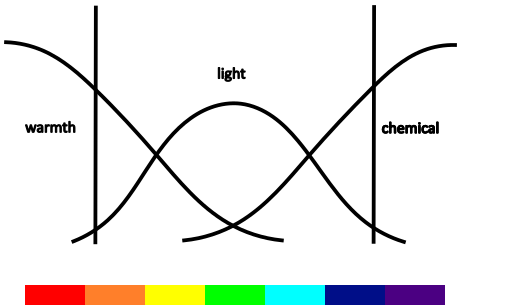Color Theory and Light
GA 91
3 August 1903, Berlin
Translated by Steiner Online Library
Lecture Two
When the Sun's rays are refracted by a prism and caught on an opposite wall, the circle of the Sun's disk is stretched in length, yielding at its edges all the colors of the solar spectrum from red to violet. This spectrum exerts a threefold effect: as heat, light and chemical effect. And it does so in such a way that red emits the most heat, which gradually decreases towards yellow. In the middle between yellow and green is the light band (the part with the strongest light effect). The blue shades, with purple being the strongest, produce chemical effects.

If rays pass through a glass sphere containing an alum solution, the spot of light obtained at the other end will probably shine, but will not give off heat, because the alum solution has absorbed it and let the light through.
Iodine dissolved in carbon disulfide would make the light spot appear as a dark spot, but one that contains heat and can ignite substances. Thus, this solution would have retained the light and given off the heat. This proves that matter is an entity endowed with determinate properties and freely attracts and repels.
A prism with rock salt solution or made of rock salt would show that the strongest heat emission still goes beyond the red, thus providing evidence that there are still other rays that we cannot perceive with our eyes. These invisible warmth rays are the infrared ones. Beyond the purple, the chemical effects still reveal invisible ultraviolet rays.
So a spectrum would be composed of these three different fields of forces. From one side, the warmth line, which decreases toward the center; and from there, the rise of the chemical force line, which is strongest in the ultraviolet. Into the center of both projects the line of light.
The eye perceives colors because it is constructed to produce colors. If the eye perceives a red object on a white background and now looks away, the same object will appear as the illusion of green on a white background. The eye that has seen red demands green. Yellow demands indigo, yellow-green demands violet. These colors that demand to be complemented are called complementary colors. They are colors that together make white—they demand each other.
An eye that cannot produce blue colors would see the forest as yellow, and violet would appear red to it.
Every color demands its counterpart, and complementary colors exert an aesthetic effect.
Farben- und Lichtlehre II
Wenn die Sonnenstrahlen durch ein Prisma gebrochen auf einer gegenüberliegenden Wand aufgefangen werden, so wird der Kreis der Sonnenscheibe in die Länge gezogen und ergibt an ihren Rändern alle Farben des Sonnenspektrums von Rot bis Violett. Dieses Spektrum übt eine dreifache Wirkung aus: als Wärme, als Licht und chemische Wirkung. Und zwar so, dass Rot am meisten Wärme ausstrahlt, die allmählich nach Gelb zu abnimmt. In der Mitte zwischen Gelb und Grün wäre das Lichtband (der Streifen mit der stärksten Lichtwirkung). Die blauen Nuancen, am stärksten Violett, bringen chemische Wirkungen hervor.

Wenn die Strahlen durch eine Glaskugel hindurchgehen, die eine Alaunlösung enthält, so wird der aufgefangene Lichtpunkt wohl leuchten, aber keine Wärme abgeben, weil die Alaunlösung sie aufgesogen hat und das Licht durchlässt.
Jod in Schwefelkohlenstoff aufgelöst würde den Lichtpunkt als dunklen Punkt erscheinen lassen, der aber Hitze enthält und Stoffe entzünden kann. So hätte diese Lösung das Licht behalten und die Wärme abgegeben.
Dies beweist, dass die Materie eine mit bestimmen Eigenschaften begabte Wesenheit ist, die in freier Weise anzieht und abstößt.
Ein Prisma mit Steinsalzlösung oder aus Steinsalz würde zeigen, dass die stärkste Wärmeentwicklung noch über das Rote hinausgeht, und so den Beweis liefern, dass noch Strahlen vorhanden sind, die wir mit unserem Auge nicht wahrnehmen können. Diese unsichtbaren Wärmestrahlen sind die ultraroten. Über das Violette hinaus lassen die chemischen Wirkungen noch unsichtbare ultraviolette Strahlen erkennen.
So würde ein Spektrum sich aus diesen drei verschiedenen Kräftefeldern zusammensetzen. Von der einen Seite die Wärmelinie, die nach der Mitte zu abnimmt; und von da das Aufsteigen der chemischen Kräftelinie, die im Ultravioletten am stärksten [ist]. In die Mitte von beiden ragt die Lichtlinie hinein.
Das Auge nimmt Farben wahr, weil es so konstruiert ist, dass es Farben erzeugt. Wenn das Auge auf weißem Grunde einen roten Gegenstand wahrnimmt und nun fortsieht, so wird derselbe Gegenstand in der Illusion als Grün auf weißem Grunde erscheinen. Das Auge, das Rot gesehen [hat], verlangt nach Grün. Gelb verlangt Indigo, Gelbgrün [verlangt] Violett. Man nennt diese Farben, die nach Ergänzung verlangen, Komplementärfarben. Es sind Farben, die zusammen Weiß ergeben - sie fordern sich gegenseitig.
Ein Auge, das keine blaue Farben erzeugen kann, würde den Wald gelb sehen, und Violett würde ihm rot erscheinen /unleserlich].
Jede Farbe fordert ihren Gegenpol, und ergänzende Farben üben eine ästhetische Wirkung aus.

